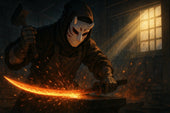Understanding the anatomy of swords offers invaluable insights for enthusiasts, historians, and collectors alike. Swords have been more than just weapons throughout history; they represent the craftsmanship, culture, and technological advancements of their time. This guide explores the intricate details of both historical and modern swords, providing a detailed examination of their structure and components. From the iconic medieval longsword to the elegant katana and the refined rapier, this guide delves into the design and purpose behind each part of the sword.
Overview of Sword Anatomy
Basic Components of a Sword
Swords, regardless of their origin, share several fundamental components:
- Blade: The cutting or thrusting part of the sword, usually made from steel. It can be straight or curved, single-edged or double-edged, depending on the type of sword.
- Hilt: The handle of the sword, which includes the grip, pommel, and guard.
- Guard: A crosspiece or other structure that protects the hand from an opponent's blade.
- Pommel: The counterweight at the end of the hilt, which helps balance the sword and can also be used as a striking tool.
- Scabbard: The sheath used to house the blade when it is not in use.
Each of these components serves a specific function, contributing to the sword’s overall effectiveness in combat.
Variations in Sword Anatomy
The anatomy of a sword can vary greatly depending on its intended use and cultural origin. For instance, the long, double-edged blade of a European longsword is designed for powerful slashing and thrusting, while the curved, single-edged blade of a katana is optimised for precise, cutting strikes. This section will explore how different cultures have adapted the basic components of swords to suit their unique combat styles and environments.
Detailed Anatomy of Specific Swords
The Longsword
- Blade: Typically double-edged, ranging from 85 to 110 cm in length, designed for both slashing and thrusting.
- Crossguard: A straight crosspiece that protects the wielder's hands, often simple in design but occasionally ornate.
- Grip: Usually long enough for two-handed use, wrapped in leather or cord for better grip and control.
- Pommel: A heavy, often rounded or faceted counterweight that balances the blade and can be used to strike.

The Katana
- Blade: A curved, single-edged blade with a sharp edge and a Hamon (temper line), typically around 60 to 80 cm in length.
- Tsuba (Guard): Often round or square, richly decorated, serving both functional and aesthetic purposes.
- Tsuka (Handle): Wrapped in intricate designs, providing a secure grip, with a length that accommodates two hands.
- Saya (Scabbard): A lacquered wooden sheath that protects the blade and plays a significant role in traditional Japanese swordsmanship.

The Rapier
- Blade: Slender, sharp, and designed primarily for thrusting, typically measuring 100 to 130 cm.
- Hilt: A complex guard with loops and knuckle guards, often highly ornate and reflective of the period’s fashion.
- Grip: Ergonomically designed, often wrapped with wire or wood, providing excellent control during duels.
- Pommel: Provides balance and often features decorative elements.

From the Bronze Age to the Iron Age: A Tale of Metal and Might
The story of sword design is like a blockbuster epic, filled with dramatic shifts, shiny new materials, and ingenious innovations. Early warriors wielded bronze swords—impressive for their time but prone to bending and breaking at the worst possible moments. With the advent of the Iron Age, swordsmiths cranked up the cool factor, creating blades that were stronger, sharper, and far more reliable. Iron, and later steel, allowed for the creation of longer and more durable swords, turning what were once rudimentary tools into masterpieces of weaponry. These advancements reshaped sword anatomy, leading to the development of features like longer blades, intricate hilts, and guards that were not only functional but also works of art.
Cultural Influences on Sword Anatomy: How the World Sharpened Its Blades
Swords are more than just tools of war; they’re reflections of the cultures that forged them. Across the world, societies developed swords that perfectly matched their combat styles and cultural ideals. In Europe, where knights in heavy armour dominated the battlefield, swords were designed to be broad, heavy, and capable of powerful slashing blows. These weapons needed to cut through armour and shields, making strength and durability key priorities. In Japan, however, the samurai crafted the katana, a sword celebrated for its precision, sharpness, and ability to deliver devastatingly accurate cuts. The design of the katana, with its curved blade and single edge, was ideal for the swift, fluid combat styles favoured by Japanese warriors. Meanwhile, in the Middle East, the curved scimitars were perfect for slashing attacks on horseback, and in India, the tulwar’s distinctive curve made it highly effective in close combat. These diverse designs highlight how different cultures adapted their swords to meet specific needs, turning them into symbols of national identity as much as tools of war.
Practical Applications of Sword Anatomy Knowledge: Not Just for the History Buffs
Understanding the intricacies of sword anatomy goes beyond academic interest—it has practical value for collectors, historians, and enthusiasts alike.
Collecting and Identifying Swords: Sharpening Your Skills
For those with a passion for swords, knowledge of their anatomy is essential for building a collection. Every part of a sword, from the blade to the pommel, offers clues about its origin, age, and authenticity. Collectors need to pay attention to materials, construction methods, and design features, as these elements can differentiate a genuine antique from a reproduction. The type of metal used, the style of engraving, and the technique of blade construction, such as pattern welding, are all critical factors in determining a sword’s provenance. By understanding these details, collectors can more confidently identify and authenticate historical swords, ensuring that each piece in their collection is truly special.
Sword Maintenance and Restoration: Keeping Your Collection Battle-Ready
Owning a sword is like holding a piece of history in your hands, and maintaining that history requires care and knowledge. Swords, particularly older ones, are susceptible to rust, corrosion, and other forms of deterioration. Proper maintenance is crucial to preserve their condition and value. This involves regular cleaning to prevent damage, methods for preserving the blade and hilt, and careful restoration of any worn or damaged parts. Whether it’s a single heirloom or an entire collection, keeping swords in pristine condition ensures they remain a testament to the craftsmanship of their makers, ready to be admired for generations to come.
Understanding the anatomy of swords is essential for appreciating their historical significance, collecting, and practicing martial arts. This guide has provided a detailed look at various types of swords, their components, and the evolution of their design. Explore our infographics for a visual breakdown of each sword, and share this content with others who share a passion for these fascinating weapons.




















































